Science Circus
New events
Sciencetival, Slovenia 2010
Some interesting demonstration excerpts from the Sciencetival held in Ljubljana Slovenia May 27-30 2010. Two of the short videos feature Stanley Micklavzina who was invited to participate in the festival. Also interesting is the Non-Newtonian Fluid, a large trough of corn starch mixed with water. Click the image for more...
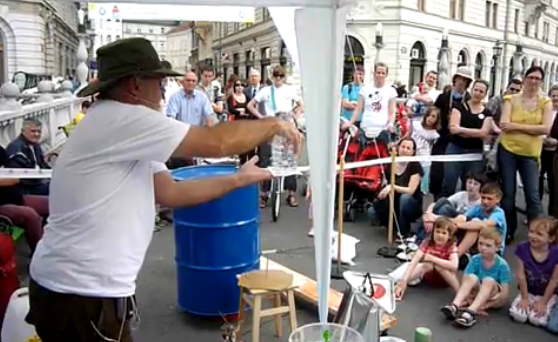
OMSI Science Pub April 8, 2010
Click the image for more...
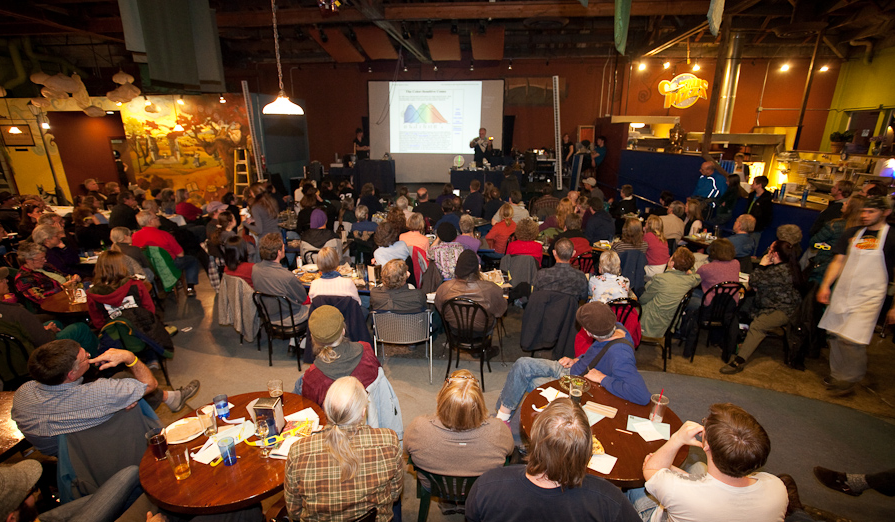
About Science Circus

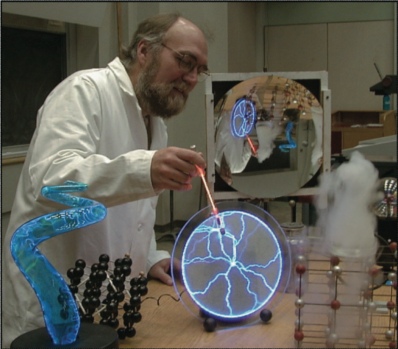 Dr. Stan's Science Circus is an annual event held off campus to promote science to the public. The shows are designed to entertain and educate community members of all ages. The young get excited with the experiments performed on stage and the older ones get insights to the physical world around them from the explanations associated with the demonstrations. Performance is an important issue in these shows, so the science is presented in a creative way for all to enjoy and to also open the mind up to the experience. All types of the performing arts has been tapped for show including circus juggling, music, story telling, dance, and even mini plays.
Dr. Stan's Science Circus is an annual event held off campus to promote science to the public. The shows are designed to entertain and educate community members of all ages. The young get excited with the experiments performed on stage and the older ones get insights to the physical world around them from the explanations associated with the demonstrations. Performance is an important issue in these shows, so the science is presented in a creative way for all to enjoy and to also open the mind up to the experience. All types of the performing arts has been tapped for show including circus juggling, music, story telling, dance, and even mini plays. 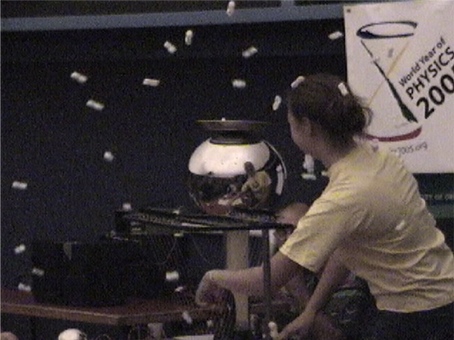
Stanley Micklavzina is the writer, director, and producer of these shows, He is very active and respected in regional, national and international professional societies in the area of physics education. These include the American Association of Physics Teachers (AAPT), where he has served as Chair of the Committee on Science Education for the Public, the Oregon Section of the AAPT, the United Kingdom-based Institute of Physics, where he serves on the Advisory Board for the Physics Education Journal, and the Pacific Northwest Association of College Physics (PNACP), where he is a member on the Board of Directors. He has served a four-year executive sequence as Vice President, President Elect, President, and Past President of PIRA, the Physics Instructional Resource Association, an affiliate of the American Association of Physics Teachers (AAPT). He has also published articles in various physics education journals and given presentations, organized workshops, and coordinated lecture demonstration shows at national and international meetings. He is also involved in the writing of grant proposals to develop science education at all levels of education including bringing science to the general public. The stage shows are also made possible through the efforts of undergraduate staff and volunteers who assist with the set-up of the shows and also perform in the show. The local chapter of the Society of Physics Students is also involved with the development and presentation of show and staff tables with interactive physics demonstrations that are set up in the venue’s lobby.
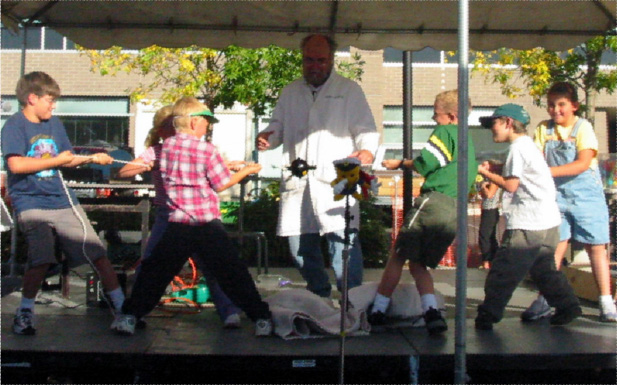
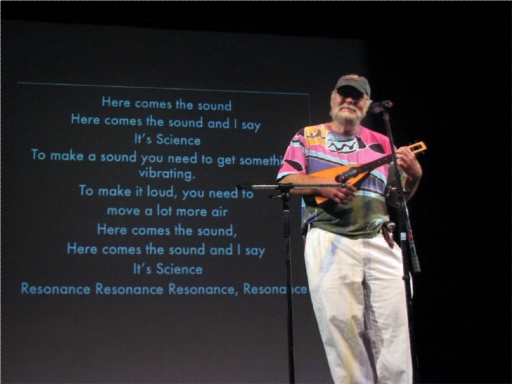 Stan’s success and influence as a physics demonstrator has been recognized nationally:
Stan’s success and influence as a physics demonstrator has been recognized nationally:
- He was honored by being invited to give the James Gerhart Lecture at the 2005 Pacific Northwest Association of College Physics (PNACP) meeting.
- For the international planning meeting in Montreal for World Year of Physics 2005, the American Physical Society tapped Micklavzina to represent the Pacific Northwest at the gathering of 70 physics lecture-demonstrators from 29 countries.
- He was awarded a $10,000 grant from the American Physical Society to take Physics on the Road during the World Year of Physics 2005, an international effort to promote the understanding of physics and the importance of physics research to the general public.
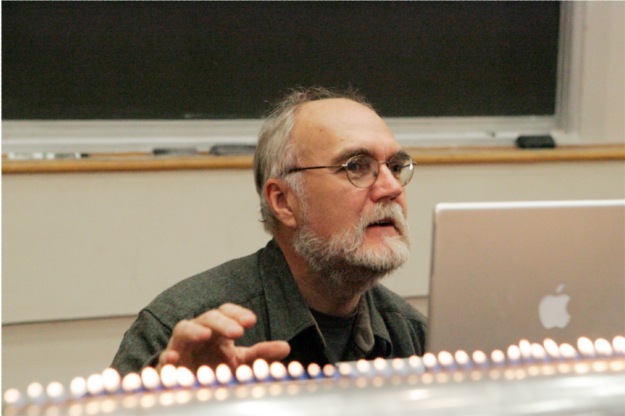 Stan continues to work on ways to take it to the next level. He developed the Super Science Circus, a public event with Portland circus performer Rhys Thomas of Jugglemania that was held at South Eugene High School auditorium in March of 2005. They were also invited by the American Physical Society to do shows in coordination with the International Science Fair held in Phoenix, Arizona. They traveled to Phoenix and performed five shows for over 2000 public school students. In 2007 –2008 the next level has been to incorporate other types of performance with physic demonstrations. His Science Circus show in March of 2008 featured physics undergraduates doing types of performance, such as story telling, and dance, to display the physics principles. In Edmonton Canada, July of 2008, Stan produced the longtime annual AAPT Summer National meeting Demo Show with Wendy Sadler, a colleague from the United Kingdom. Part of the show featured acts that were the result of a Physics and Performance workshop they ran at the same meeting two days earlier. The show was attended by over 900 physics teachers and members of the public and has been called the most innovative Demo Show ever produced at an AAPT meeting. More background about the show and a video of the show can be seen at: http://uoregon.edu/~physdemo/edmontonshow/ . He and Wendy also authored an article about the show, which was published in the Physics Education Journal.
Stan continues to work on ways to take it to the next level. He developed the Super Science Circus, a public event with Portland circus performer Rhys Thomas of Jugglemania that was held at South Eugene High School auditorium in March of 2005. They were also invited by the American Physical Society to do shows in coordination with the International Science Fair held in Phoenix, Arizona. They traveled to Phoenix and performed five shows for over 2000 public school students. In 2007 –2008 the next level has been to incorporate other types of performance with physic demonstrations. His Science Circus show in March of 2008 featured physics undergraduates doing types of performance, such as story telling, and dance, to display the physics principles. In Edmonton Canada, July of 2008, Stan produced the longtime annual AAPT Summer National meeting Demo Show with Wendy Sadler, a colleague from the United Kingdom. Part of the show featured acts that were the result of a Physics and Performance workshop they ran at the same meeting two days earlier. The show was attended by over 900 physics teachers and members of the public and has been called the most innovative Demo Show ever produced at an AAPT meeting. More background about the show and a video of the show can be seen at: http://uoregon.edu/~physdemo/edmontonshow/ . He and Wendy also authored an article about the show, which was published in the Physics Education Journal.
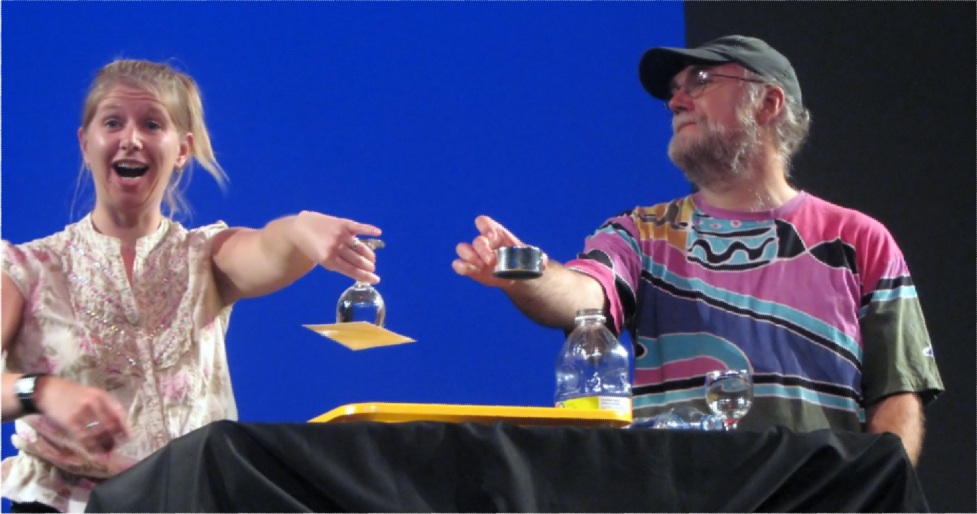
On Oct. 28, 2008, Stan and Rhys Thomas teamed up again and did a presentation at the OMSI sponsored Science Pub in Portland Oregon which had over 300 people in attendance, which at the time was the highest Science Pub attendance OMSI has ever had.
Stan has also presented his physics shows, or has been involved with shows, at an annual Physics teachers seminar in Puebla Mexico, the AAAS meeting in Ashland Oregon, Davinci Days in Corvallis, the Oregon Country Fair, ORAAPT meeting in Vancouver Washington, 2008 AAPT national meeting in Edmonton Canada, as well as Portland, Salt Lake City, Lund Sweden, Ljubljana Slovenia, and Perugia Italy, among others. Stan even developed one show especially for Native American students visiting our campus.
The Science Circus is intended to excite and educate the general community to the wonder of the universe and the importance of science education and research. Ultimately, we would love to see the young minds open up to the world of science exploration and expand the numbers of future scientists! As Einstein once stated " In the matter of physics the first lessons should contain nothing but what is experimental and interesting to see. A pretty experiment is in itself, often more valuable than twenty formulae extracted from our minds." Add performance to the experiment, and you get the minds of the observer to see what they have missed before.
Last modified: Wed Jun 10 15:29:15 PDT 2009



 Dr. Stan's Science Circus is an annual event held off campus to promote science to the public. The shows are designed to entertain and educate community members of all ages. The young get excited with the experiments performed on stage and the older ones get insights to the physical world around them from the explanations associated with the demonstrations. Performance is an important issue in these shows, so the science is presented in a creative way for all to enjoy and to also open the mind up to the experience. All types of the performing arts has been tapped for show including circus juggling, music, story telling, dance, and even mini plays.
Dr. Stan's Science Circus is an annual event held off campus to promote science to the public. The shows are designed to entertain and educate community members of all ages. The young get excited with the experiments performed on stage and the older ones get insights to the physical world around them from the explanations associated with the demonstrations. Performance is an important issue in these shows, so the science is presented in a creative way for all to enjoy and to also open the mind up to the experience. All types of the performing arts has been tapped for show including circus juggling, music, story telling, dance, and even mini plays. 

 Stan’s success and influence as a physics demonstrator has been recognized nationally:
Stan’s success and influence as a physics demonstrator has been recognized nationally:
 Stan continues to work on ways to take it to the next level. He developed the Super Science Circus, a public event with Portland circus performer Rhys Thomas of
Stan continues to work on ways to take it to the next level. He developed the Super Science Circus, a public event with Portland circus performer Rhys Thomas of 